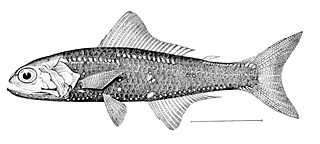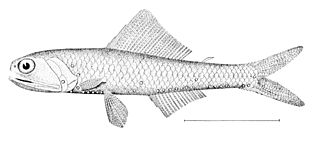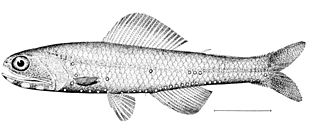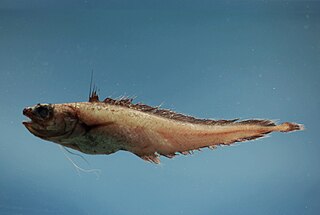
The Atlantic mackerel, also known as Boston mackerel, Norwegian mackerel, Scottish mackerel or just mackerel, is a species of mackerel found in the temperate waters of the Mediterranean Sea, the Black Sea, and the northern Atlantic Ocean, where it is extremely common and occurs in huge shoals in the pelagic zone down to about 200 m (660 ft). It spends the warmer months close to shore and near the ocean surface, appearing along the coast in spring and departing with the arrival of colder weather in the fall and winter months. During the fall and winter, it migrates out into deeper and more southern water, seeking warmer temperatures.
The scaly dragonfish or boa dragonfish, is a medium-sized abyssal barbeled dragonfish of the family Stomiidae. It is found at great depths worldwide in tropical to temperate oceans but is absent from the northern Pacific and northwest Atlantic Oceans.

The queen angelfish, also known as the blue angelfish, golden angelfish or yellow angelfish, is species of marine ray-finned fish, a marine angelfish belonging to the family Pomacanthidae. It is commonly found near reefs in the warmer sections of the western Atlantic Ocean.

The cardinalfish, also known as the Mediterranean cardinalfish or king of the mullets, is a species in the family of Apogonidae (cardinalfishes). It is widely distributed in the Mediterranean and along the warm temperate and tropical eastern Atlantic coasts from Portugal south to the Gulf of Guinea.
Vinciguerria poweriae is a species of lightfish belonging to the genus Vinciguerria. They are mostly found in seawater 300–600 metres (1,000–2,000 ft) deep during the day and 50–350 metres (160–1,150 ft) deep at night. They feed on small crustaceans.
Vinciguerria lucetia is a species of marine ray-finned fish in the genus Vinciguerria known by the common name Panama lightfish. It is a small bioluminescent fish, with two rows of tiny photophores along its body. It is very abundant in the tropical Indo-Pacific where it makes large vertical migrations each day.

Helicolenus dactylopterus is a marine bony fish from the family Sebastidae, also known as blackbelly rosefish, bluemouth rockfish, and bluemouth seaperch. This Atlantic species is a typical sit-and-wait predator with a highly cryptic coloration.

The common seasnail is a small marine fish of the seasnail family (Liparidae) in the order Scorpaeniformes, the scorpionfishes and flatheads. It is found in the northeastern Atlantic Ocean where it lives on the seabed.

Argyropelecus affinis is a species of ray-finned fish in the family Sternoptychidae, found in the tropical and subtropical Atlantic, Indian and Pacific Oceans. Common names for this fish include Pacific hatchetfish, deepsea hatchetfish and slender hatchetfish. It inhabits the mesopelagic zone and is either non-migratory or performs short daily vertical migrations.

Argyropelecus sladeni, or Sladen's hatchetfish, is a species of ray-finned fish in the family Sternoptychidae, found in the tropical and subtropical Atlantic, Indian and Pacific Oceans. This small fish lives in the mesopelagic zone by day and makes a daily vertical migration to the epipelagic zone at night.
Astronesthes richardsoni, or Richardson's snaggletooth, is a species of small, deep sea fish in the family Stomiidae. It occurs in the tropical western Atlantic Ocean, the Caribbean Sea and the Gulf of Mexico. First described by the Cuban zoologist Felipe Poey in 1852, it was named Chauliodus richardsoni in honour of the Scottish explorer and naturalist John Richardson. It was later transferred to the genus Astronesthes.

Astronesthes niger, commonly known as snaggletooth, is a species of small, deep sea fish in the family Stomiidae. It occurs in the tropical and subtropical Atlantic Ocean, the Caribbean Sea and the Gulf of Mexico, as well as the Indian Ocean and western Pacific Ocean, at depths to 1,000 m (3,300 ft).

Notoscopelus elongatus is a species of lanternfish in the family Myctophidae. It is endemic to the Mediterranean Sea where it is found in deep water habitats, rising to near the surface to feed at night and descending to great depths by day. It is a common species with no particular threats, and the International Union for Conservation of Nature has listed its conservation status as being of least concern.

Notoscopelus resplendens, commonly known as the patchwork lampfish or patchwork lanternfish, is a species of lanternfish in the family Myctophidae. It is found in the eastern and western Atlantic Ocean, the Indian Ocean and parts of the Pacific Ocean. It spends the daylight hours in deep water, rising at night to near the surface. This fish was first described by the Scottish naturalist and arctic explorer John Richardson in 1845.

Notoscopelus caudispinosus is a species of lanternfish in the family Myctophidae. It is found in the eastern and western Atlantic Ocean, the Indian Ocean and parts of the Pacific Ocean. It spends the day below 1,000 m (3,300 ft), rising towards the surface to feed at night.

Notoscopelus kroyeri, commonly known as the lancet fish, is a species of lanternfish in the family Myctophidae. It is endemic to the North Atlantic Ocean where it is found in deep water habitats, spending its day at great depths and its night near the surface. It was previously regarded by some authorities as being a subspecies of Notoscopelus elongatus; one of the differences between the two being that N. elongatus has 25 or fewer gill rakers while N. kroyeri has 26 or more.

Cottunculus microps, the polar sculpin, is a species of fathead sculpin, a deepwater fish found in the North Atlantic and Arctic Oceans. It was first described in 1875 by the Norwegian zoologist Robert Collett, curator of the Natural History Museum at the University of Oslo.

The Atlantic batfish is a species of fish in the family Ogcocephalidae. It is found in deep water in the Atlantic Ocean where it lives on the seabed, feeding on small invertebrates.

The short beard codling is a species of marine bony fish in the family Moridae. Native to the western Atlantic Ocean, it is found on the continental slope at depths between 50 and 1,620 m.
Barbantus curvifrons, commonly known as the palebelly searsid, is a species of ray-finned fish known from the Indian Ocean, the Pacific Ocean and the eastern Atlantic Ocean where it has been found at depths below 500 metres (1,600 ft). The generic name Barbantus is derived from the Latin, "barba", a beard.















